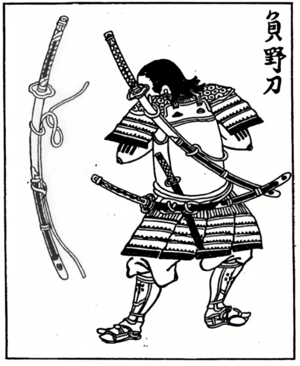Scabbard facts for kids
A scabbard is like a special case or cover for a sword, knife, or other large blade. It keeps the blade safe and helps people carry it easily. Horse riders also used scabbards for their rifles, like carbines or lever action rifles, to protect them while riding.
Scabbards have been made from many different materials over thousands of years. Some were made of leather or wood, while others used metals like brass or steel. Most sword scabbards were worn hanging from a sword belt or a shoulder strap called a baldric.
Contents
Scabbards in Ancient Times
In ancient times, wooden scabbards were often covered with fabric or leather. Leather scabbards usually had metal parts added for extra protection and to make them easier to carry.
Japanese swords, for example, have their sharp edges protected by a wooden scabbard called a saya.
Many scabbards used by ancient Greeks and Romans were small and light. Their main job was to hold the sword, not necessarily to protect it from heavy damage.
All-metal scabbards were popular among rich people in Europe during the Iron Age. These were often decorated with fancy designs to show off wealth. We don't know much about very early Iron Age scabbards because they were made of wood and didn't last. However, later in the Iron Age, scabbards became important for showing off detailed artwork. After 200 BC, fully decorated scabbards became less common.
Some old scabbards have been found at places where ancient people offered weapons as gifts to their gods. A few of these scabbards had fur lining inside. This fur was probably kept oily, which helped stop the blade from rusting. The fur also made it easier and faster to pull the sword out.
Scabbards in Modern Times
Completely metal scabbards became popular in Europe in the early 1800s. They eventually replaced most other types. Metal was stronger than leather and could handle the tough conditions of battles, especially for soldiers on horseback. Metal scabbards also looked more military and could be decorated more.
Even so, leather scabbards were still used by soldiers. They were common as late as the American Civil War (1861–1865).
Sometimes, military police, naval patrols, and other groups used leather scabbards as a type of truncheon (a short, thick stick used as a weapon).
Historically, scabbards were rarely worn across the back. Only a few Celtic tribes did this, and only with very short swords. This is because pulling a long, sharp sword over your shoulder and past your head from a back scabbard is very difficult, especially if you need to do it quickly. Your arm length also limits how long a blade you can even draw this way.
Parts of a Scabbard
The metal piece where the blade goes into the scabbard is called the throat. This throat is often part of a bigger metal fitting called a mount or locket. This locket usually has a ring or stud to help you wear the sword.
For leather scabbards, the blade's tip is usually protected by a metal tip or chape. On both leather and metal scabbards, this tip often has an extra part called a drag or shoe to protect it from wearing out.
Images for kids
-
Mounting for a Japanese short sword (wakizashi) 18th century. Metropolitan Museum of Art
See also
 In Spanish: Vaina para niños
In Spanish: Vaina para niños





